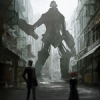Quote:
Original post by nibbuler
Here's a page for the side of the head... since that looks like the area you need most help on.
http://www.fineart.sk/show.php?w=11
Interesting. Got anything for non-caucasians?
Quote:
It looks to me like the pen size is too large. Decrease it so you're forced to draw more precisely.
I'll give that a shot. Note that it was drawing in a "rough out" fashion, which means that I went over some of the lines several times as I was trying to get comfortable with the pad.
Quote:
And as a side note, very little looks better on a white background than black. :}
Actually, I went with the red pencil because I was going to color it, but I didn't like the colored version at all - I think the use of flat shading with a pencil didn't help. ArtRage Free doesn't provide any tools appropriate for inking, and I'm still looking for something else that works as a digital drawing tool not trying to mimic natural media.
Quote:
The best advice I can give you is to start at the beginning of the Loomis books and draw everything in them, page by page. Good luck, God speed.
Thanks, and thanks. I'll grab those books and work through them; they sound like just what I was looking for. I'll still pick up an anatomy book next week, though. I need a better understanding of the underlying musculo-skeletal structure.







